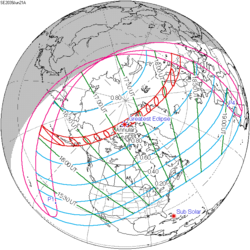| Partial eclipse | |
| Gamma | −1.1405 |
|---|---|
| Magnitude | 0.7199 |
| Maximum eclipse | |
| Coordinates | 72°12′S30°24′W / 72.2°S 30.4°W |
| Times (UTC) | |
| Greatest eclipse | 20:10:31 |
| References | |
| Saros | 150 (20 of 71) |
| Catalog # (SE5000) | 9669 |
A partial solar eclipse will occur at the Moon's descending node of orbit on Saturday, March 19, 2072, [1] with a magnitude of 0.7199. A solar eclipse occurs when the Moon passes between Earth and the Sun, thereby totally or partly obscuring the image of the Sun for a viewer on Earth. A partial solar eclipse occurs in the polar regions of the Earth when the center of the Moon's shadow misses the Earth.
Contents
- Eclipse details
- Eclipse season
- Related eclipses
- Eclipses in 2072
- Metonic
- Tzolkinex
- Half-Saros
- Tritos
- Solar Saros 150
- Inex
- Triad
- Solar eclipses of 2069–2072
- Saros 150
- Metonic series
- Tritos series
- Inex series
- References
- External links
The partial solar eclipse will be visible for parts of Antarctica and southern South America.






































































































